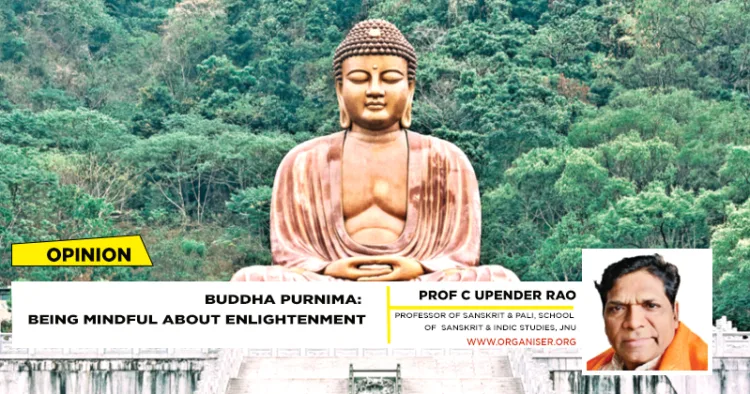Gautama was born in the Northern part of India, in what is now Nepal, around 2,600 years ago, attained enlightenment and taught the truth, which he had realised. The exact date of Buddha’s birth is not definitively known, as historical records from the time of his life are scarce and there are variations in dating systems. However, according to traditional accounts and scholarly consensus, it is generally believed that Siddhartha Gautama, who later became known as Buddha, was born around 6th century BCE. Buddha’s birthday is commonly celebrated on the full moon day of Vaishakha month, which usually falls in April or May in the Gregorian calendar. This commemoration is observed by Buddhists worldwide as Vesak or Buddha Purnima. In the beginning, when Gautama attained enlightenment and started to preach his doctrine, the Dhamma, he called himself the Tathāgata, while his disciples called him Bhagavān, the Blessed One. Others spoke of him as Gautama or Śākyamuni.
Buddha is a generic name, which means “one who has attained Enlightenment i.e., one who has realised the Truth”. The word Buddha is a past participle derived from the root budh (to wake). But when Buddhism reached foreign lands, the name Buddha was pronounced in indigenous ways. In Chinese, the usual form for Buddha is Fo, and in Japanese it is Butsu, Butsuda, or Hotoku. In Vietnamese, Buddha is typically referred to as Phat. In Cambodia, Buddha is commonly called Puth Bun, which translates to Putthabat.

Buddha renounces the world just after the birth of a son. He sees the four omens before his renunciation: an old man, a sick man, a dead man and a recluse. There are several Buddhas according to Buddhist legends. Some Buddhas see all four on the same day. Others, like Vipassi Buddha, saw these omens at long intervals. After his enlightenment, Buddha did not preach till he was requested to do so by God Mahā Brahmā. This was so in order to make the world pay greater attention to Buddha and his teachings. Buddha generally travels from the bodhi tree to Isipatana for his first sermon, through the air, but Gautama went on foot because he wished to meet Upaka on the way.
Similarities and Differences
Both Hindu Dharma and Buddha Dharma are similar due to historical and doctrinal factors. Historically, both of these Dharmas originated in ancient Bharat and share some common cultural and philosophical roots. Siddhartha Gautama, who later became known as Buddha, was born into a Hindu family and was familiar with Hindu teachings and practices. As He sought enlightenment and later developed his spiritual path, Buddhism emerged as a distinct tradition. Doctrinally, while there are similarities between Hinduism and Buddhism, such as concepts of karma and rebirth, there are also some differences. For example, Hinduism emphasises the authority of the Vedas and the existence of a Supreme Being (Brahman) that manifests in various forms of Gods and Goddesses, while Buddhism does not posit the existence of a Supreme Being and focuses on Buddha’s teachings such as Four Noble Truths and the Eightfold Path as the means to achieve liberation from suffering.
Both Hindu Dharma and Buddha Dharma are similar due to historical and doctrinal factors. Historically, both of these Dharmas originated in ancient Bharat
Over time, these doctrinal differences led to the development of separate religious traditions with their distinct rituals, scriptures, and philosophical perspectives. Despite this division, there have been interactions and exchanges between Hinduism and Buddhism throughout history. In some regions, aspects of both traditions have blended, leading to syncretic practices. Some scholars intentionally use the word Brahmanic instead of Vedic or Hindu. The appropriateness of the word Brahmanic depends on the context in which it’s used. Brahmanic typically relates to Brahmanism, the religious and social system associated with the Brahmins. In discussions about religion, culture, or history related to Brahmins, the word Brahmanic might be appropriate, if it accurately describes the subject matter. However, it is essential to be mindful of how the term is used and ensure it is not being used in a derogatory or insensitive manner.
Vedic and Buddhist philosophies do share similarities, especially considering their common origin in ancient Bharat and the historical and cultural context in which they developed. Both Vedic and Buddhist traditions believe in the concept of karma, the law of cause and effect, where actions have consequences that affect future experiences. Both believe in the cycle of birth, death and rebirth. Both traditions emphasise the importance of renunciation and detachment from worldly desires as a means to attain spiritual liberation or enlightenment (moksha or nirvana). Both Vedic and Buddhist philosophies provide ethical guidelines for living a virtuous life, often emphasising compassion, non-violence, truthfulness and other moral virtues. Both traditions incorporate various forms of meditation as a means to cultivate mindfulness, insight, and spiritual growth.
Attainment of Buddhahood
The attainment of Buddhahood means becoming Buddha by obtaining bodhi i.e. enlightenment. Therefore, Buddhahood comprises the knowledge attained by the enlightenment and the way by which one becomes Buddha. Here the doctrine and the practice are directed to the same goal, i.e., the attainment of Buddhahood. Buddhist doctrine was studied and put into shape in the different schools and with time developed itself into such concepts as the ‘non-existence’ of the Mādhyamika School, the ‘idealism’ of the Vijñānavādins. It may be said that in the long history of Buddhism, its chief concern has been the attainment of Buddhahood. Gautama’s attainment of the unsurpassed bodhi was at once the release from suffering.
Tripitaka Was Written in Bharat
Sri Lankans spread the information that the Tripitaka text was first written in their country. However, recent research revealed that Tripitaka was available in written form in Bharat till the time of Ashoka. We also get to know about it from the Bhabru inscription of Ashoka. Among all the inscriptions engraved by Ashoka, the Bhabru inscription has a special place in the context of Buddhist literature, especially in the context of Pali literature. The main reason for this is that in this inscription Ashoka requests Buddhist followers to read and know some selected Pali suttas. The Bhabru inscription has been found at a place called Bhabru, twelve miles away from a place called Bairat near Jaipur in Rajasthan. Therefore, this inscription is called Bairat or Bhabru inscription, after the name of the place where it was found. Presently, this inscription is in the Bengal Asiatic Society Museum in Kolkata, the capital of West Bengal, due to which it is also called the Bairat-Calcutta inscription. The names of the suttas, inscribed on the Bhabru inscription of Ashoka, also underline the fact that the transcription of Pali suttas was very much present in Bharat to a larger extent. The Sinhalese tradition that the Buddha’s words were first transcribed in Sri Lanka is not archaeologically correct.
The very meaning of the word Tripitaka shows that there were three baskets. The name commonly used by Theravadins and other Buddhists for their scriptures is Tipitaka. The word Tipitaka is made up of two words – Tri + Pitaka. Here tri means three and pitaka means basket. Thus, Tripitaka means ‘three boxes’. It seems that the word Tripitaka came into use when Buddha’s words started being written down. That is when Buddha’s words started being written down and kept in a box, the word Tripitaka was used. In the early part of Pali Tripitaka, the word Pitaka is found only in the sense of a box.
In today’s fast-paced and stressful world, the practice of mindfulness and meditation, which are important in Buddha Dharma, have become increasingly valuable. These practices promote mental clarity, emotional resilience, and inner peace, helping individuals cope with challenges and cultivate a greater sense of well-being.
Ethical Guidelines
Buddha Dharma emphasises ethical conduct, including principles such as non-violence, honesty, compassion, and generosity. In a world marked by social injustices, environmental crises and interpersonal conflicts, these ethical guidelines provide a moral compass for navigating complex ethical dilemmas and promoting harmony and social justice. Buddha’s teachings on interconnectedness and impermanence resonate deeply with contemporary environmental concerns. *Buddha Dharma emphasises the interconnectedness of all beings and the impermanence of the natural world, inspiring ecological awareness, sustainable living practices, and environmental stewardship. *Buddha Dharma offers a path of personal growth and transformation, encouraging individuals to cultivate wisdom, compassion, and inner peace. By practising mindfulness, ethical living, and self-reflection, individuals can develop greater self-awareness, resilience, and emotional well-being, leading to personal growth and spiritual fulfilment.



















Comments